High in Sodium: Highly Charged Tungsten Ions May Diagnose Fusion Energy Reactors

(PhysOrg.com) -- Just as health-food manufacturers work on developing the best possible sodium substitutes for low-salt diets, physicists at the National Institute of Standards and Technology have acquired new knowledge on a promising sodium alternative of their own. Sodium-like tungsten ions could pepper -- and conveniently monitor -- the hot plasma soup inside fusion energy devices, potential sources of abundant, clean power.
Tungsten—having the highest melting point of any metal—will be used in some high-strength structural components in the experimental ITER fusion reactor under construction in France (see www.physorg.com/news111336748.html). When ITER cooks up its hot, dense fusion plasma, it could erode trace amounts of tungsten from its structures and strip away many of its electrons in the process. When 63 of tungsten’s 74 electrons are removed, it becomes chemically analogous to sodium atoms, which have 11 electrons as well.
Ordinary sodium gas radiates bright yellow-orange light, which has proven useful for everything from mundane streetlamps to exotic atom lasers. Sodium radiates approximately 99 percent of its visible light in two shades of orange, which scientists have termed the “D” spectral lines.
Sodium-like tungsten ions emit intense light in analogous “D” spectral lines, but they are at far higher energy levels than sodium, and so are shifted out of the visible spectrum to the extreme ultraviolet. Measuring the wavelengths and relative intensities of lines in the spectrum of light released by a population of tungsten ions in the plasma can provide information about the fusion plasma conditions, such as its temperature, density and magnetic fields. Yet it has been challenging to measure light in this portion of the electromagnetic spectrum.
NIST’s John Gillaspy and his colleagues have now provided the first measurement of both “D” lines in sodium-like tungsten, confirming theoretical predictions of their energies and intensities. The NIST scientists further checked their knowledge by measuring the spectrum of light from other sodium-like ions of hafnium, tantalum and gold. The researchers used NIST’s electron beam ion trap (EBIT), which employs an electron beam to make, catch and study highly charged ions. To measure the spectra, they used an extreme ultraviolet (EUV) spectrometer, originally developed to study 13.5 nanometer wavelength light emitted from plasma sources for next-generation microelectronics applications, but they discovered they could push it to detect radiation as low as about 2 nanometers, where tungsten’s lower-wavelength “D” line resides. With this experimental knowledge of tungsten’s lines, researchers may now have a robust new ingredient for measuring fusion reactor conditions.
More information: J.D. Gillaspy, I.N. Draganic, Y. Ralchenko, J. Reader, J.N. Tan, J.M. Pomeroy and S.M. Brewer Measurement of the D-line doublet in high-Z highly charged sodiumlike ions. Physical Review A, Published online 8 July 2009. doi: 10.1103/PhysRevA.80.010501
Provided by National Institute of Standards and Technology (news : web)

















